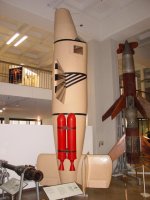World War II led to the creation of some truly bizarre and unconventional aircraft as nations scrambled to gain a technological edge. Among the strangest was the Bachem Ba 349 Natter.
Named after a snake, the Natter was a rocket-powered interceptor designed for vertical takeoff, much like the infamous V-2 missile. Once airborne, the pilot would guide it toward a formation of American bombers and unleash a barrage of rockets. After the attack, the pilot would eject and descend by parachute while the aircraft's fuselage did the same separately...


Today, only two Natters are known to survive. One remains in storage under the care of the Smithsonian Institution in the United States, while another is displayed at the Deutsches Museum in Munich. The fate of the other [two] captured Natters remains unknown.

A U.S. engineer lifts the hinged canopy of a captured Bachem Ba 349 to take a look inside the cockpit. Photo credit: Smithsonian Magazine
Named after a snake, the Natter was a rocket-powered interceptor designed for vertical takeoff, much like the infamous V-2 missile. Once airborne, the pilot would guide it toward a formation of American bombers and unleash a barrage of rockets. After the attack, the pilot would eject and descend by parachute while the aircraft's fuselage did the same separately...


Today, only two Natters are known to survive. One remains in storage under the care of the Smithsonian Institution in the United States, while another is displayed at the Deutsches Museum in Munich. The fate of the other [two] captured Natters remains unknown.

A U.S. engineer lifts the hinged canopy of a captured Bachem Ba 349 to take a look inside the cockpit. Photo credit: Smithsonian Magazine








